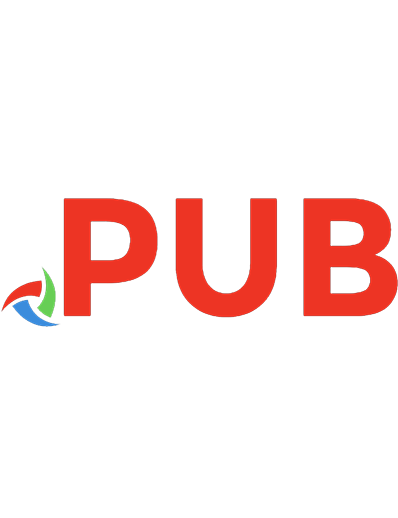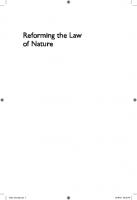Prayer and the Priesthood of Christ in the Reformed Tradition 9781472549976, 9780567042415
“In this book Graham Redding provides a detailed account of prayer in the Reformed tradition, and a critical examination
225 70 13MB
English Pages [326] Year 2003
Polecaj historie
Citation preview
Acknowledgements This study is the product of doctoral research and parish ministry. It is intended for liturgists and parish ministers as well as students and teachers of theology. To the people of Somervell Memorial Presbyterian Church I owe a debt of thanks, not only for being partners in prayer and ministry for nine wonderful years, during which time this research was completed, but for their willingness to grant me a one-year sabbatical, their financial support, and their encouragement to complete my doctoral studies. To my doctoral supervisor, Professor Alan Torrance, I also owe much. It was he who first opened my eyes to the fact that theology, properly understood, is grounded in the act of worship and should never be an exercise in abstract speculation. His friendship and encouragement and, above all, his sheer enthusiasm for theology, have meant a great deal. Professor Torrance, of course, is related to the two leading figures in this book, the Very Reverend Thomas F. Torrance and Professor James B. Torrance. It has been a privilege to meet both these gentlemen and a joy to discover that they are churchmen of immense wisdom and men of prayer, as well as theologians of considerable stature. For the very kind hospitality extended by James and Mary Torrance towards my family during our brief stay in Edinburgh, I am especially grateful. I acknowledge with love and gratitude the support provided by my wife Jenni, especially during our year in London. It was a wonderful year in so many ways, not least in relation to our family life together. Last, but not least, I acknowledge my mother, Colleen, who, during the course of my research, struggled with terminal cancer. I rejoice that such a difficult period saw grace and peace flourish in her life. It became a time of prayer, in which the priesthood of Christ was very evident on a personal level. It is to the memory of my mother, whose life and humanity was joined to and clothed with Christ's in the final weeks of her life, that this volume is dedicated.
Introduction
Defining the Issue and Setting the Agenda In his book, Worship, Community and the Triune God of Grace, James Torrance makes the critical observation that most worship today 'is in practice unitarian, has no doctrine of the mediator or sole priesthood of Christ, is humancentred, has no proper doctrine of the Holy Spirit, is too often non-sacramental, and can engender weariness'.] Accordingly, worship and prayer are regarded as things that we do - no doubt enabled by God's grace and following Jesus' example - but still things that we do. 'In theological language,' says Torrance, 'this means that the only priesthood is our priesthood, the only offering our offering, the only intercessions our intercession^.'^ What is intriguing about this description of the unitarian nature of contemporary worship and prayer is that, to the extent that it is true, it flies in the face of a strong revival of trinitarian doctrine that has been sweeping through the Church in recent decades. R. J. Feenstra and C. Plantinga note that 'virtually every serious theological movement of recent years has sought on its own terms to state and shape trinitarian d ~ c t r i n e ' .Commenting ~ on the same trend, Colin Gunton notes its truly ecumenical nature. Treatises on the Trinity, he says, now represent all the main traditions of Christendom: 'Roman Catholic (Kasper), Orthodox (Zizioulas), Lutheran (Jensen), Reformed (Moltrnann) and Anglican ( B r ~ w n ) 'Liberation .~ J. B. Torrance, Worship, Cornnzunity and the Triune God of Grace (Downers Grove, Illinois: Intervarsity Press, 1996), p. 20. Torrance, Worship, Cornrnl~nityand the Triune God of Grace, p. 20. R. J. Feenstra and C. Plantinga, Jr, eds, Trinity, Incarnation, and Atonement: Philosophical and Theological Essays (Notre Dame, Indiana: University of Notre Dame Press, 1989), p. 3. C. E. Gunton, The Pron~iseof Trinitarian Theology (Edinburgh: T&T Clark, 1991),p. 1.
1 The Impact of Arianism and Apollinarianism on Liturgical Development, and its Legacy in the Christian West: The Jungmam-Torrance Thesis I
While the primary context of this book is the Reformed tradition, and in particular the Church of Scotland, it is important to acknowledge that the debates waged within that tradition often have their conceptual origins in the debates of the early Church. This is so in relation to the doctrine of the priesthood of Christ, at the centre of which stand two fundamental questions: (1) What is the nature and significance of the hypostatic union between God and humankind in the person of Christ?; and (2) What is the nature of Christ's mediatorial or priestly activity in relation to (a) the atonement, and (b) worship and prayer? If the second question focuses mainly on the work of Christ, it cannot be answered without addressing the first, and indeed primary, question of who Christ is. It was this first questionwhich occupied the attention of the Church Fathers at the Councilof Nicea in AD 325 as they sought to settle the issue of whether the Son was truly homootisios to patri, of one being with the Father, in whose very own person God and creation were clasped together in a reconciling union, or whether he was but a created intermediary,a kind of bridging figure between an eternal God and a transient created order who is neither fully God nor fully human. Both doctrinal positions employed biblical texts in support of their respective arguments, and both recognised in Christ a mediatorial function, but they understood that function in contrastingways, reflecting not only different soteriologiesat work, but also conflicting epistemologies and world-views, one Hebraic (unitive)the other Greek (dualistic). Much more was at stake in this debate than the definition of orthodoxy at a doctrinal level. Also at stake
2 The Significance of the Doctrine of the Priesthood of Christ for John Calvin and the Early Scottish Reformed Tradition John Calvin The hypostatic union, the priesthood of Christ and the wonderful exchange One of the distinctive features of the Reformation was the renewed emphasis given to the priesthood of Christ, an emphasis that, as we noted in the previous chapter, had been steadily eroded since the fourth century through the Church's confrontation with Arianism and the subtle influence of Apollinarianism, with poignant consequences for medieval doctrine and liturgical development, especially in the Latin West. While there was considerable diversity of opinion among the Reformers themselves, as fierce debates over such matters as sacrifice and real presence demonstrate, there was nevertheless a unifying conviction that the liturgy is the work not of priests on the people's behalf, but of the whole people of God under the sole priesthood of Christ. This conviction was more than an ecclesiastical reaction against the excesses and distortions of medieval clericalism. It was theologically driven, and these theological convictions provided the impetus for liturgical reform, even if the reform itself was carried out without detailed knowledge of the origins and principles of w0rship.l Of particular interest to us in this chapter is the conb-ibution of John Calvin to the Reformed theological emphasis upon the priesthood of Christ, for it is only by understanding his doctrinal position that we will be able to assess the extent to which federal Calvinism maintained Cf. W . D. Maxwell, A n Outline of Christian Worship: Its Developnze~ttnnd F o r m (London: Oxford University Press, 1936), pp. 72-3.
3 Federal Calvinism and the Westminster Tradition, and their Legacy in Reformed Liturgical Developments Key Questions If the doctrine of predestination expounded by Calvin and the early Scottish Reformers of the sixteenth century left their soteriology and understanding of the Christian life vulnerable to the possibility of being recast in a more legalistic, contractual and introspective mould, the question which must be asked is, To what extent did this actually happen as Calvinism became a real force on the Reformed ecclesiastical landscape in seventeenth-century Britain? T. F. and J. B. Torrance stand within a school of thought which claims there are significant and irreconcilable differences between the Calvinistic doctrines of the seventeenth-century Westminster documents and those doctrines expounded by Calvin himself in the sixteenth century and built upon by the 'older Scottish tradition', of which John Knox and John Craig were leading figures. In recent years this claim has been challenged, most notably by Paul Helm, Robert Letham and Richard Muller, who claim continuity rather than discontinuity, and faithfulness rather than distortion in relation to Calvinism's development of Calvin's doctrinal system. The debate tends to concentrate on three interrelated issues: (a) The extent to which Calvin's Genevan successor, Theodore Beza, rather than Calvin himself, determined the direction of Reformed theology, especially in Great Britain; (b) The influence of federal theology on the Westrninster tradition; and (c) The influence of Puritanism, and in particular William Perkins, on Reformed doctrine and worship. It is to these issues that we will now turn before we conclude the chapter with a brief survey of the key doctrinal features of the Westminster documents, especially as they pertain to the priesthood of Christ.









![Serving the Body of Christ : The Magisterium on Eucharist and Ordained Priesthood [1 ed.]
9781587683183, 9780809148509](https://dokumen.pub/img/200x200/serving-the-body-of-christ-the-magisterium-on-eucharist-and-ordained-priesthood-1nbsped-9781587683183-9780809148509.jpg)
